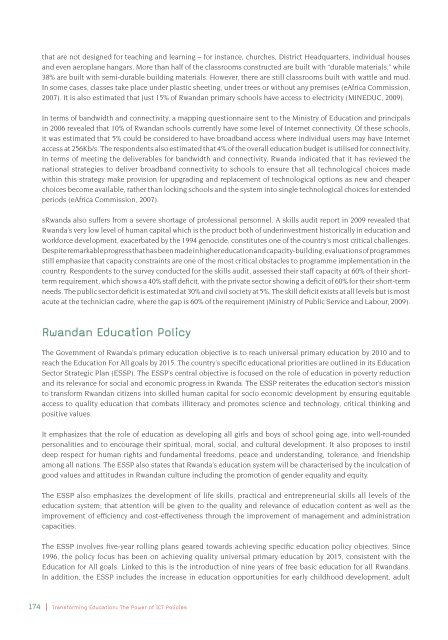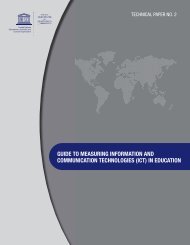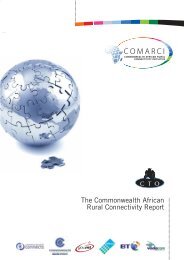Transforming education: the power of ICT policies - Commonwealth ...
Transforming education: the power of ICT policies - Commonwealth ...
Transforming education: the power of ICT policies - Commonwealth ...
You also want an ePaper? Increase the reach of your titles
YUMPU automatically turns print PDFs into web optimized ePapers that Google loves.
that are not designed for teaching and learning – for instance, churches, District Headquarters, individual houses<br />
and even aeroplane hangars. More than half <strong>of</strong> <strong>the</strong> classrooms constructed are built with “durable materials,” while<br />
38% are built with semi-durable building materials. However, <strong>the</strong>re are still classrooms built with wattle and mud.<br />
In some cases, classes take place under plastic sheeting, under trees or without any premises (eAfrica Commission,<br />
2007). It is also estimated that just 15% <strong>of</strong> Rwandan primary schools have access to electricity (MINEDUC, 2009).<br />
In terms <strong>of</strong> bandwidth and connectivity, a mapping questionnaire sent to <strong>the</strong> Ministry <strong>of</strong> Education and principals<br />
in 2006 revealed that 10% <strong>of</strong> Rwandan schools currently have some level <strong>of</strong> Internet connectivity. Of <strong>the</strong>se schools,<br />
it was estimated that 5% could be considered to have broadband access where individual users may have Internet<br />
access at 256Kb/s. The respondents also estimated that 4% <strong>of</strong> <strong>the</strong> overall <strong>education</strong> budget is utilised for connectivity.<br />
In terms <strong>of</strong> meeting <strong>the</strong> deliverables for bandwidth and connectivity, Rwanda indicated that it has reviewed <strong>the</strong><br />
national strategies to deliver broadband connectivity to schools to ensure that all technological choices made<br />
within this strategy make provision for upgrading and replacement <strong>of</strong> technological options as new and cheaper<br />
choices become available, ra<strong>the</strong>r than locking schools and <strong>the</strong> system into single technological choices for extended<br />
periods (eAfrica Commission, 2007).<br />
sRwanda also suffers from a severe shortage <strong>of</strong> pr<strong>of</strong>essional personnel. A skills audit report in 2009 revealed that<br />
Rwanda’s very low level <strong>of</strong> human capital which is <strong>the</strong> product both <strong>of</strong> underinvestment historically in <strong>education</strong> and<br />
workforce development, exacerbated by <strong>the</strong> 1994 genocide, constitutes one <strong>of</strong> <strong>the</strong> country’s most critical challenges.<br />
Despite remarkable progress that has been made in higher <strong>education</strong> and capacity-building, evaluations <strong>of</strong> programmes<br />
still emphasize that capacity constraints are one <strong>of</strong> <strong>the</strong> most critical obstacles to programme implementation in <strong>the</strong><br />
country. Respondents to <strong>the</strong> survey conducted for <strong>the</strong> skills audit, assessed <strong>the</strong>ir staff capacity at 60% <strong>of</strong> <strong>the</strong>ir shortterm<br />
requirement, which shows a 40% staff defi cit, with <strong>the</strong> private sector showing a defi cit <strong>of</strong> 60% for <strong>the</strong>ir short-term<br />
needs. The public sector defi cit is estimated at 30% and civil society at 5%. The skill defi cit exists at all levels but is most<br />
acute at <strong>the</strong> technician cadre, where <strong>the</strong> gap is 60% <strong>of</strong> <strong>the</strong> requirement (Ministry <strong>of</strong> Public Service and Labour, 2009).<br />
Rwandan Education Policy<br />
The Government <strong>of</strong> Rwanda’s primary <strong>education</strong> objective is to reach universal primary <strong>education</strong> by 2010 and to<br />
reach <strong>the</strong> Education For All goals by 2015. The country’s specifi c <strong>education</strong>al priorities are outlined in its Education<br />
Sector Strategic Plan (ESSP). The ESSP’s central objective is focused on <strong>the</strong> role <strong>of</strong> <strong>education</strong> in poverty reduction<br />
and its relevance for social and economic progress in Rwanda. The ESSP reiterates <strong>the</strong> <strong>education</strong> sector’s mission<br />
to transform Rwandan citizens into skilled human capital for socio economic development by ensuring equitable<br />
access to quality <strong>education</strong> that combats illiteracy and promotes science and technology, critical thinking and<br />
positive values.<br />
It emphasizes that <strong>the</strong> role <strong>of</strong> <strong>education</strong> as developing all girls and boys <strong>of</strong> school going age, into well-rounded<br />
personalities and to encourage <strong>the</strong>ir spiritual, moral, social, and cultural development. It also proposes to instil<br />
deep respect for human rights and fundamental freedoms, peace and understanding, tolerance, and friendship<br />
among all nations. The ESSP also states that Rwanda’s <strong>education</strong> system will be characterised by <strong>the</strong> inculcation <strong>of</strong><br />
good values and attitudes in Rwandan culture including <strong>the</strong> promotion <strong>of</strong> gender equality and equity.<br />
The ESSP also emphasizes <strong>the</strong> development <strong>of</strong> life skills, practical and entrepreneurial skills all levels <strong>of</strong> <strong>the</strong><br />
<strong>education</strong> system; that attention will be given to <strong>the</strong> quality and relevance <strong>of</strong> <strong>education</strong> content as well as <strong>the</strong><br />
improvement <strong>of</strong> effi ciency and cost-effectiveness through <strong>the</strong> improvement <strong>of</strong> management and administration<br />
capacities.<br />
The ESSP involves fi ve-year rolling plans geared towards achieving specifi c <strong>education</strong> policy objectives. Since<br />
1996, <strong>the</strong> policy focus has been on achieving quality universal primary <strong>education</strong> by 2015, consistent with <strong>the</strong><br />
Education for All goals. Linked to this is <strong>the</strong> introduction <strong>of</strong> nine years <strong>of</strong> free basic <strong>education</strong> for all Rwandans.<br />
In addition, <strong>the</strong> ESSP includes <strong>the</strong> increase in <strong>education</strong> opportunities for early childhood development, adult<br />
174 | <strong>Transforming</strong> Education: The Power <strong>of</strong> <strong>ICT</strong> Policies
















